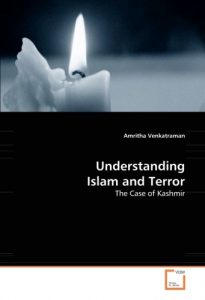
Originally written as a thesis; Amritha Venkatraman’s Kashmir: Islam and Terror, strives to trace the trajectory of the Kashmir conflict and to determine the place Islamic terrorism holds in the conflict. The author posits that extreme interpretations of the Quran and Revivalism cause religious violence in Kashmir, ‘The conflict between India and Pakistan has been seen to violate Shariat and thus in turn induced Quranically induced violent Jihad in Kashmir’.
The book essentially comprises four components each constituting one full chapter. The first chapter ‘Setting the Stage: History of Kashmir Crisis’ provides an in-depth and well thought out background of the Conflict, the emphasis is not on the chronology of the events that transpired rather the author makes a concerted effort to understand the ‘why’ aspect. This in turn helps to bring out all the concerned actors in the conflict – Kashmiri people, India, Pakistan, Islamic militants and ROW (Rest of the World) and what stakes does Kashmir hold for them.
The influence a range of Hindu, Sikh and Mughal rulers at various points in history exercised on religious practices in Kashmir is also charted out. The author also provides an introduction to the phenomenon of Islamization of Muslim sufferings by Pakistan and Islamic institutions. An exercise in geo-political history; the chapter examines the development of Indian and Pakistani territorial demands in the Kashmir crisis and showcases how these desires have caused political, religious and military violence there.
The second Chapter ‘Religious Basis for Islamic Terrorism: The Quran and its Interpretations’ provides a theological dimension to the study of terrorism in Kashmir, it analyses how far the powers of Ijtihad or independent reasoning have an impact on extreme interpretations of the Quran which in turn validate violent responses in a situation where Shariat is ‘adjudged’ to be threatened.
In order to better understand the notion of Kashmiriyat the author also examines how Sufi beliefs held by the citizens of the valley are quite different from the tenets of Wahhabism and Deobandi schools of Islamic thought prevalent in Pakistan. Islamic history which has been shaped in large part by public provision of ijtihad is also discussed; the author provides a preliminary knowledge of five basic sects in Islam – Shia, Sunni, Wahhabi, Sufi and Ahmaddiyat and four essential Islamic practices. These are: Modernism, Pragmatism, Traditionalism and Fundamentalism. This addition of explaining fundamental differences in Islam makes the picture slightly crystalline when one ponders over the question as to ‘what constitutes a Kafir? And as to why there is violence within the structure of ummah as well. The movement of Revivalism with special reference to the Kashmir conflict is also discussed.
With the ushering in of this religious lens; a framework is provided to the reader for understanding the legitimization of violence by Islamic terrorist groups in modern times. The author also provides accounts of Kashmiri society becoming more traditionalist (Quran as a comprehensive living system; harks back to the classical period of Islam to implement discourses) in its outlook due to the influx of Pakistani sponsored Madrasas and fundamentalist organizations. By making the reader aware of this significant yet gradual change the author touches upon the need for Pakistan to Islamisize the syncretic traditions of the valley with its brand of Sunni Islam in order to assert greater legitimacy whilst putting forth its case for the integration of Kashmir to Pakistan.
Chapter-3 of the book ‘The Insurgency: Historical and Religious Interpretations Manifested’ combines the previous themes of geopolitical history as well as the Quran’s discourse on violence to showcase the ideological apparatus under which the terrorist groups in the valley operate. Here ‘the incongruence between the Shariat and the on-going affairs of an Islamic society can provide cause for violent Jihad, external or inter-communal. . The author divides the insurgency into two phases on the basis of the end objective –
Phase 1 (1989-1994) – Islamic terrorists encouraged participants of Phase I to use violent Jihad against India and on occasion Pakistan, in order to establish political independence in Kashmir. Kashmir’s history also provided a political agenda for the religious objectives of Phase I. This is because participants used violent Jihad to try to establish an autonomous state. A few of the more important groups that fought for a pro-independence agenda in Kashmir were the Jammu and Kashmir Liberation Front (JKLF), the Muslim Janbaaz force (MJF) and the Ikhwan-Ul-Mujahideen (IUL), while analysing the operations performed by these groups the author brings about the psychological complexities of Phase I which essentially involved a ‘crusader mentality’, and a quest for an Islamic identity alongside avenging perceived historical injustices. As Quranic discourse minimised the fear of death, in this period the ideology of violent jihad finds root in the pan-Islamic sentiment of establishing Islamic sovereignty in contemporary inter-communal conflicts.
Phase I fizzled out due to a growing void in leadership due to Indian counter-insurgency operations and diversion of Pakistani resources to more pro – Pakistan oriented Phase II terrorists. The insurgency movement also shifted away from a politico-Islamic to extremist narratives
For instance, in the Phase, I emphasis was laid upon the fact that on the matter of governance Shariat states that “People are to be free and in possession of democratic rights” Kashmiri people being denied those rights become catalysts for violent reprisals. In extremist interpretations of Quran during Phase II it was believed that Muslim people should be ruled by a Muslim head of state and Muslim resources harnessed for the growth of the Umma and not for a nation of unbelievers this also prompted more clergy driven and violent jihad against unbelievers during the latter phase.
Phase II (1994-ongoing ) is an extreme religious representation of Pakistani demands in the Kashmir crisis, The Phase II emerged with an objective to establish Islamic justice by uniting Kashmir with Pakistan. The influence of Wahhabism on traditional Madrassas such as the Jaamait, Deoband, Al-Hadith and Barewli schools encourages the violent method chosen by Phase II Jihadis to obtain religious justice in Kashmir. In this section, the author describes the ideological apparatus and operations undertaken by a few terror groups such as Hizbul Mujahideen, Harkat-ul Ansar, Lashkar and Jaish this puts the notion of ‘Islamic terrorism’ into real-world perspective while providing a fresh dimension to look at terrorism not from the mind of security forces but the organizations actually engaged in it.
Chapter 4 titled ‘The Kashmir Crisis and Insurgency: Repercussions and What Next?’ contains the various policy initiatives that can be undertaken in order to pacify the interests of all the groups. This chapter also gives a detailed account of how counter-terrorism efforts by India can only be used to manage the insurgency and not entirely diminish it, because as long as there are terror organizations such as Hizbul Mujahideen and Madrasas funded by Pakistani state apparatus, which look at Kashmir’s political grievances from a lens of extreme Quranic interpretation and legitimizes violence in self-defence of the Ummah the assembly line production of fighters will not stop and fighters in the valley could adopt a mythical hydra-like formulation.
In sum Kashmir: Islam and Terror provide one with a theological perspective in Islamic radicalization, the author lays emphasis on the fact that it is not the very nature of a religion that breeds violence but the active interpretations by contemporary Islamic groups who firmly believe means justify the end. The author tries to apply the ‘clash of civilization’ thesis to the Kashmir conflict and presents Kashmir as an entity of its own, effectively negating the porous nature of LOC and ignoring the socio-cultural impact independent nation-states of India and Pakistan have on Kashmir (both POK and J&K). This thesis personifies Kashmir as an entity and is extremely useful to understand the transitional period in Kashmiri politics wherein a disenchantment from the electoral process lead to seeking of redressal of grievances by turning towards a power higher than any state’s government- spiritual. Written in an incredibly simple language the book consciously seeks to not position itself in a globalized space by not invoking 9/11.
However, the thesis can sometimes get repetitive in its assertions that extreme Quranic interpretations and revivalism are what perpetuating Islamic terrorism in Kashmir. While the layout of the themes is incredibly clear but the analysis leaves much to be desired, the author has adopted a qualitative approach but the inherent lack of excerpts of interviews and case studies makes the book a rather technical and fragmented read with ideas coming across as compartmentalized with no logical progression. Overall it’s a good preliminary read for anyone who wishes to understand the core essence of conflict in Kashmir and to obtain the larger picture.













